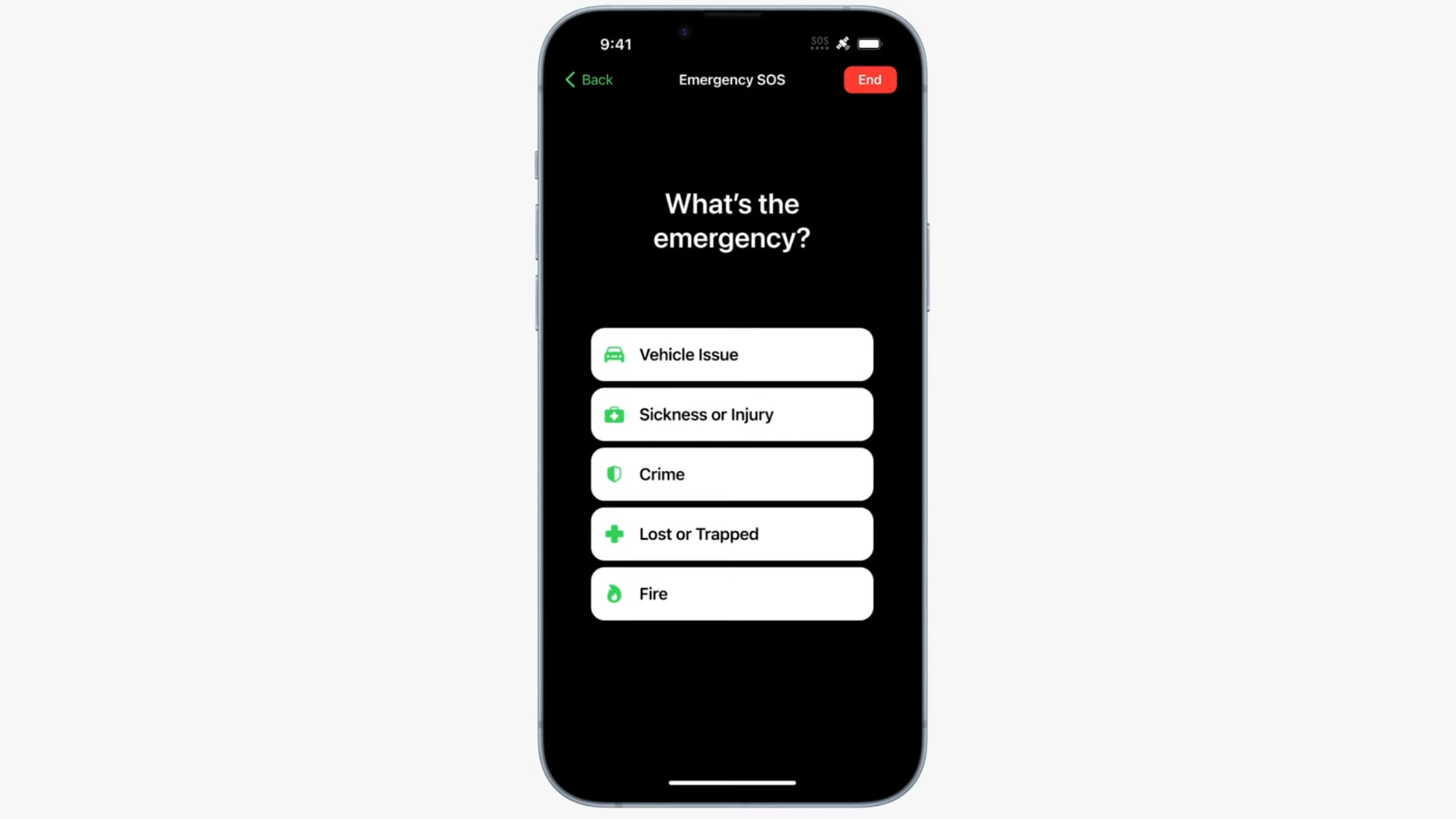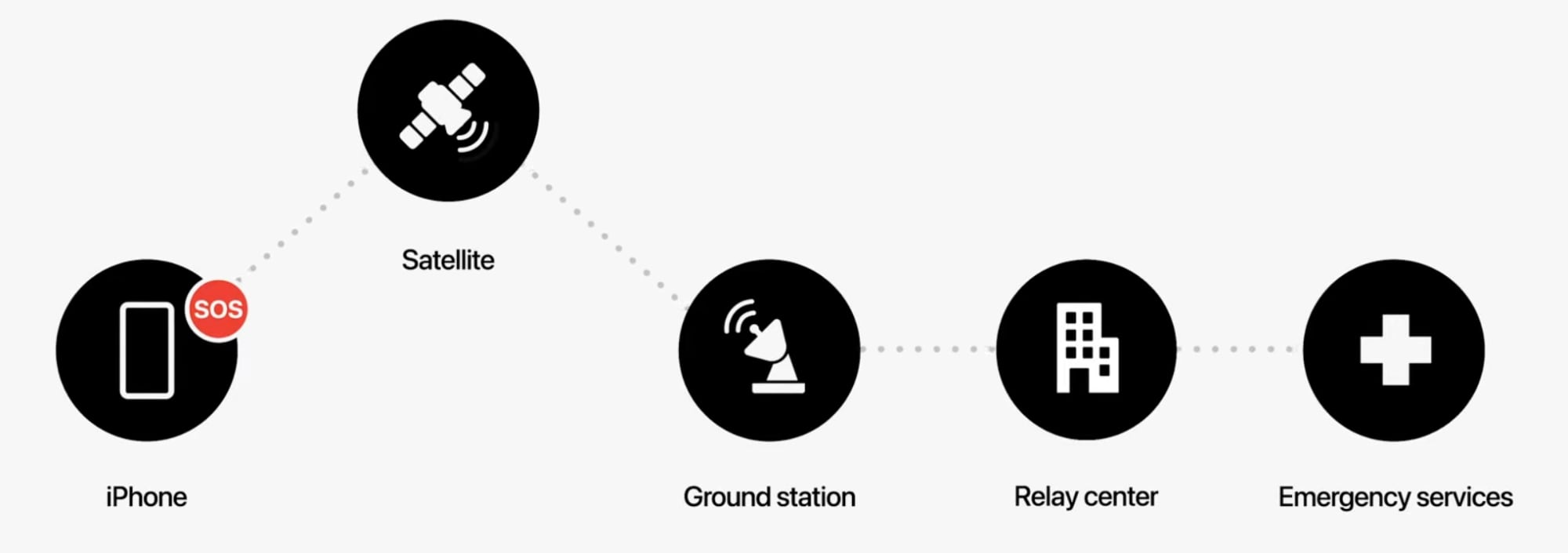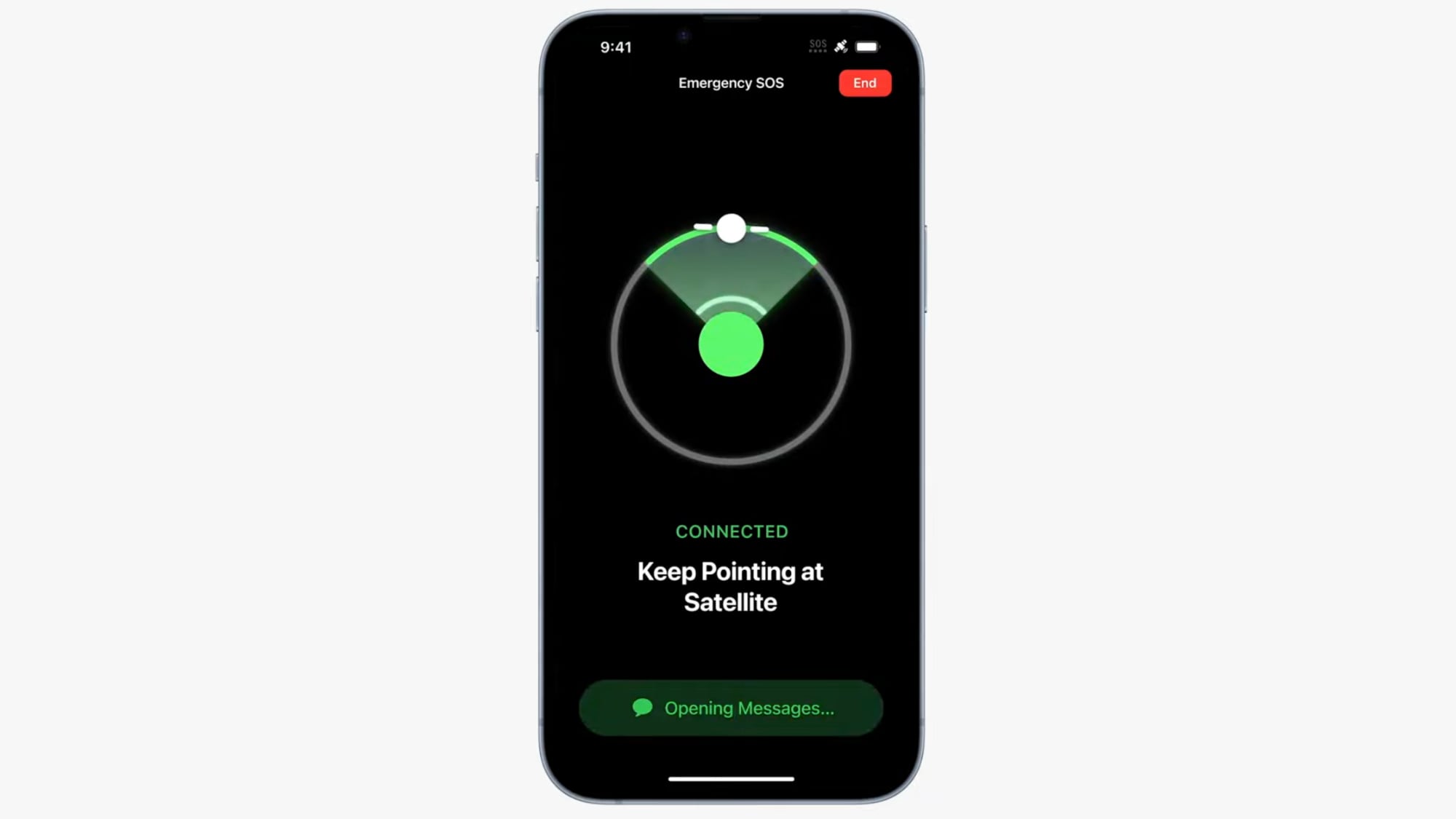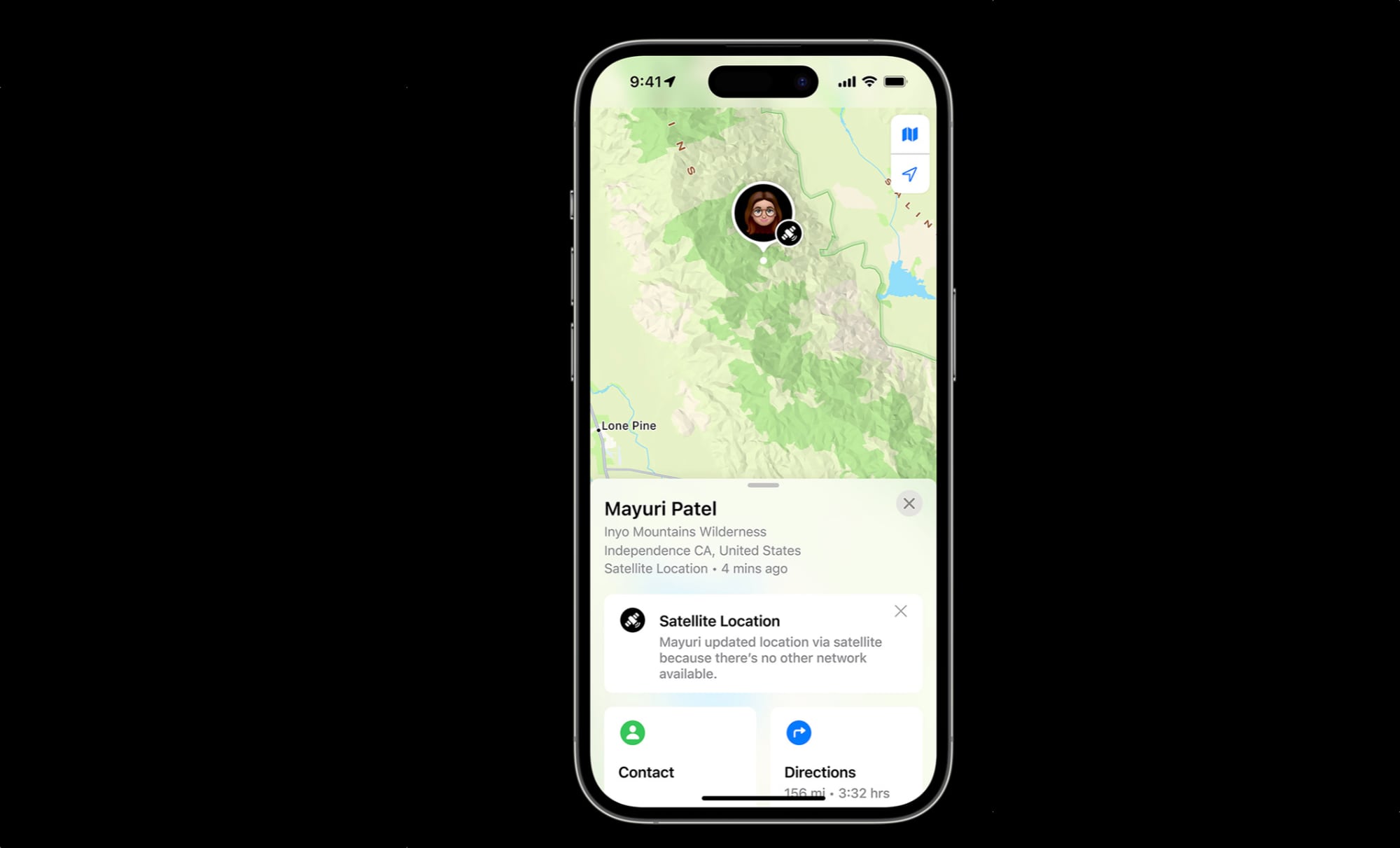Your comment reads like telecom marketing: become a customer now for something that may come in the future.Get on t mobile. This will be a standard feature
Got a tip for us?
Let us know
Become a MacRumors Supporter for $50/year with no ads, ability to filter front page stories, and private forums.
What You Need to Know About Apple's Emergency Satellite Feature for iPhone 14
- Thread starter MacRumors
- Start date
- Sort by reaction score
You are using an out of date browser. It may not display this or other websites correctly.
You should upgrade or use an alternative browser.
You should upgrade or use an alternative browser.
Don't worry - nobody knows. Whatever comes out is what's meant to come out. Trust yourself.I mean seriously, only available in USA and Canada? I don't know whether to laugh or cry.
Thanks, for now I'm smilingDon't worry - nobody knows. Whatever comes out is what's meant to come out. Trust yourself.
Wondering what the plan is after two years and someone opts not to pay and finds themselves in a life-or-death situation.
No difference from if someone lets their health insurance lapse and then gets into an accident subsequently.
I really hope they extend the free availability. I don’t really agree with having to pay for the ability to call emergency services.
Emergency Satellite Feature will only be enabled if it can't reach a cell phone tower. If the phone can reach a cell phone tower, the Emergency Satellite Feature will not be enabled. All current iPhones for sale do not have this feature. Sorry for the bold, I don't know how it got enabled.
Read the post:Does an iPhone 14 bought in other countries get satellite connectivity when they enter US/Canada? Or is it restricted to units sold in US/Canada?
Availability
Satellite connectivity will be available in the United States and Canada on all iPhone 14 models. International travelers who visit the United States and Canada can use Emergency SOS via satellite, except if they bought their phone in China mainland, Hong Kong, or Macao, as Emergency SOS via satellite isn't offered in those countries.
Apple says that Emergency SOS via satellite might not work in places above 62° latitude, such as northern parts of Canada and Alaska.
One way or another, today's message, "We'll save your life for free for two years, but after that the meter starts running at an undisclosed-for-now price" was not up to Apple's usual standard.
Even using this service in the first two years will be expensive. I know search and rescue teams can cost $5,000 or more.
This is unrelated to this service. If you are in a live-and-death situation and need rescue, be happy that someone is coming for help. And be happy that you can call for help with this service if no other option is available.Even using this service in the first two years will be expensive. I know search and rescue teams can cost $5,000 or more.
It won't/shouldn't cost $5,000 to post an off-the-grid FindMy location when you aren't lost or injured, which was a social media functionality highlighted in the Apple presentation. I saw nothing in Apple's announcement that promised free rescue, or rescue at any price. Emergency SOS establishes contact, and from there it is presumably up to you (and your existing insurance) as to how you get rescued, if that's what you need.Even using this service in the first two years will be expensive. I know search and rescue teams can cost $5,000 or more.
That's why it would make a huge amount of sense for Apple to bundle a basic tier of Emergency SOS into every Apple One subscription, and then offer additional tiers of insurance for potential rescue. Maybe let free-tier users pay a one-time exorbitant fee to make an emergency rescue call, but then offer monthly rates for two additional tiers; one that allows unlimited Emergency SOS calling, and another that bundles rescue insurance into the fee.
Fellow CO resident here. I sort of smirked at Apple's "HERE COMES THE RESCUE HELICOPTER!" dramatization. Of course there are actual rescue helicopters. But more often than not, it's volunteers who have to hike in to where you are, triage you, and *then* call in the helicopter if warranted. Otherwise, they're carrying you out. Breaking your ankle in the mountains can often mean a very long, painful, cold night alone waiting, and then a delicate hike down the next morning. The best solution to needing rescue is not to get yourself into a situation where you need rescue.
I was thinking how most people will likely never need this service, but anecdotally, my friend would have needed it some years ago.
We were hiking a 14er in CO in the shoulder season. Group got separated (the Ultra Watch siren feature would have been useful) at small distance. Which turned into a big distance. Nobody had cell service on the mountain.
Friend was stranded overnight in the snow. Rescue groups with search dogs hiked all morning and nobody could find him. It wasn't until a rescue helicopter spotted some visual evidence that helped locate him. He was flown out with some (minor) leg injuries.
Other national providers, such as Verizon and AT&T etc.Other providers as in other satellite communications companies?
Yes.
During the Spacex/T-Mobile presentation Elon said that he would welcome any other partners because what they really need is bandwidth, and national cell phone providers have to agree to let Spacex use a part of that bandwidth for this service to be a partner. Apple could ask the same thing. There is only a finite amount of frequencies that are useable, and most of them are already owned by some company or country.
I was just listening to the latest episode of Dithering (a podcast between John Gruber and Ben Thompson) and they shared that the likely reason why it's not offered as a free feature indefinitely is because Apple actually maintains call centers in these two countries (US and Canada) who are tasked with manually calling emergency services in the event that the satellite feature fails to work for the user. This isn't Apple simply collaborating with some third party and calling it a day. They actually invest money in making sure it works (and considering it's a matter of life and death, it had better).I mean seriously, only available in USA and Canada? I don't know whether to laugh or cry.
Elon/TMobile specifically asked European providers to join. I don’t know if they have asked any US telecom companies to join them or not.Tough to compare when Apple has a service ready to deploy whilst the other one is just vaporware at this point, SpaceX doesn’t even have one single v2 satellite up in the sky and service wont be another year or two. From Musk’s track record, it probably will take at least 2-3 years to get that off the ground running. I do like the fact it is supposed to work with existing devices, unlike Apple making you buy new devices to get this feature. But the downside is that in the US it seems like it will only work on Tmobile. I have to say SpaceX-Tmo announcement seemed pre-maturely rushed out to the media, with very sketchy details, like others mentioned it was probably primarily a ploy to pre-empt Apple’s announcement.
Bummer. I was ready to buy a 14 pro max for the satellite ability but live in Fairbanks, lat 64.8 I suspected sat would be an issue and now that is confirmed.
With the iPhone 14 models, Apple is introducing a new Emergency SOS via satellite feature that is designed to allow emergency messages to be sent even when cellular and WiFi connections are unavailable.
We thought we'd highlight some of the features of the new satellite functionality for those of you who are curious about how it works.
When It Works
Satellite connectivity is available to be used whenever you are out of range of WiFi or cellular and need to send an emergency message.

Apple says that it was designed for use in open spaces with a clear line of sight to the sky, so performance may be impacted if there are trees or buildings that are nearby.
Messaging Options
You can't make phone calls using the SOS via Satellite feature, but you can send short text messages. The iPhone will actually front-load vital questions to assess your situation, and it will send that information to emergency personnel as soon as you're connected.

Apple created a compression algorithm that makes text messages three times smaller to speed up communication as much as possible.
If you're in an area where emergency services can receive text messages, the text message will be sent directly, otherwise it will go to a relay center with Apple-trained specialists that will be able to place an emergency call for you.

Accessing Satellite Connectivity
Using satellite functionality requires your iPhone to connect to a satellite in the sky, so the iPhone will walk you through where to point your iPhone to get it connected to the nearest satellite.

Time Delays
Apple says that if you have a clear view of the sky, a short message can be sent within 15 seconds, but it can also take several minutes if there are obstructions.
Find My Integration
Through satellite connectivity, iPhone users can share their location over Find My even when there is no cellular or WiFi connection, which provides additional security for those camping or hiking in remote areas.

Crash Detection
The iPhone 14 models have a new dual-core accelerometer that can detect G-force measurements up to 256Gs, and a new high dynamic range gyroscope, both of which are for Crash Detection. Crash Detection is a new feature that pairs with emergency satellite, as it allows you to get help even if you crash in a remote location.
Globalstar Partnership
According to an SEC filing submitted following Apple's event, Apple is working with Globalstar on the satellite connectivity feature. Globalstar will be Apple's satellite operator, and it has agreed to allocate 85 percent of its current and future network capacity to support Apple's iPhones.
Globalstar and Apple's contract says that Globalstar will provide and maintain all resources, including personnel, software, satellite systems, and more, and maintain minimum quality and coverage standards.
Pricing
Apple has not provided details on how much satellite connectivity will cost, but all iPhone 14 users will get two years of satellite connectivity for free.
Availability
Satellite connectivity will be available in the United States and Canada on all iPhone 14 models. International travelers who visit the United States and Canada can use Emergency SOS via satellite, except if they bought their phone in China mainland, Hong Kong, or Macao, as Emergency SOS via satellite isn't offered in those countries.
Apple says that Emergency SOS via satellite might not work in places above 62° latitude, such as northern parts of Canada and Alaska.
Launch Date
Emergency SOS via satellite is set to launch in November.
Article Link: What You Need to Know About Apple's Emergency Satellite Feature for iPhone 14
But then how could they dramatically rip out the battery and sim card from their burners?This would have really helped Walt and Jesse…
Regular calls to emergency services over cellular remain free... even if your carrier has no service you can freely roam to any carrier for emergency calls. This satellite feature however is net new "off the grid" coverage. Coverage you could get today with an additional device and service. Even if it ain't free, having this ability on a device you always have with you may be well worth it for some people.I really hope they extend the free availability. I don’t really agree with having to pay for the ability to call emergency services.
You will, or they will? I mean if you fall in the desert, of course you know you fell in the desert. Unless you hit your head on that damn sand hard enoughIf you don't want to pay for that service, then you'll still know you fell in the desert.
Well, that was my next question — is it a one time thing? If not, sure thing, I usually upgrade every 1-2 years.Just buy a new phone every 24 months. Keeps Tim happy.
Any other suggestions? The iPhone has historically been about not needing to buy additional devices, quite the opposite.
where are you getting this from? You think fall detection is equivalent to launching and maintaining a satellite network?I mostly have an issue with this not being a free feature. It's like being charged for fall detection after 2 years.
Yes — it's the absolutely same thing. We good?where are you getting this from? You think fall detection is equivalent to launching and maintaining a satellite network?
I like the concept, but I won’t pay this as currently described - it’s not as safe as useful as something like the Garmin InReach.
But if it can replace the InReach, which includes some very modest messaging, I will absolutely pay for it.
The ability to check in regularly, convey that you have arrived at your preplanned points, etc. keeps you from HAVING TO USE emergency features. Then you only use SOS features when something has gone terribly wrong.
In a perfect world I’d like to prepay for 40 simple messages before a trip, or prepay 1 - 3 months, and then use the SOS in an emergency only.
yeah, I think this is more for casual hikers or folks that find themselves driving a lot in uncovered areas and find themselves in an unexpected situation like trapped by a fire or car broken down or lost. Its really clever what apple has done.
Folks that are more serious about hiking are going to get a subscription service like InReach.
Sure and you could buy a radio, a 2 way video device, an iPod, a dedicated phone, a calculator, a weather device, a camera….but it’s still a big deal when they get added to the one magical device we have all the time.This technology has been available for years in other devices. Nothing innovative really. Anyone who treks around in isolated areas have been able to buy devices to use for a long, long time.

Personal Locator Beacons: How to Choose | REI Co-op
Learn the difference between a personal locator beacon (PLB) and a satellite messenger, and which emergency signal device might be right for you.www.rei.com
That is the most ridiculous statement. They spent a good part of the watch talking about helping women get pregnant- what more wonderful than that?I saw one article that says, "Apple used to sell wonder, now it sells fear."
I haven't thought of it that way, but there is some truth to it.
Having a safety feature doesn’t mean you are selling fear. It’s means you are selling preparation.
Seriously interesting, do you have any links to actual facts? I’m curious about these things and enjoy learning new stuff, especially about physics…
Don't mean to hijack your discussion, but you can crudely estimate forces during collisions like this: acceleration is force / mass. Force is rate of change of momentum - this is the crucial bit - and momentum = mass x velocity.
Let's say you have a heads-on collision with a rock where you go at 100 mph and then you stop. 100 mph = 44.7 meters/s, so your momentum p is mass M x 44.7 kg*m/s, and after the collision p = 0;
Let's say it took you 1 s to stop because you were wearing a seatbelt and airbag was deployed, this means force F = p/t = 44.7 M kg*m/s^2, hence the acceleration is a = F/M = 44.7 m/s^2. Since g = 9.8 m/s^2, in this case a = 4.6 g.
1 s for collision time is very optimistic, if you take 0.1 s, the acceleration experienced goes up to 46 g.
Now, the estimate is very crude but if you think in terms of orders of magnitude (i.e. a is around 50), and what kinds of injuries you expect to sustain in a collision at 100 mph, and extrapolate, 250 g must mean certain death.
Last edited:
Register on MacRumors! This sidebar will go away, and you'll see fewer ads.


